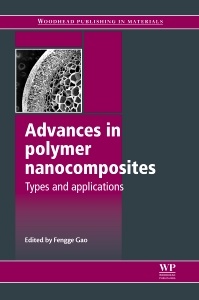Description
Advances in Polymer Nanocomposites
Types and Applications
Woodhead Publishing Series in Composites Science and Engineering Series
Coordinator: Gao Fengge
Language: English
Subject for Advances in Polymer Nanocomposites:
680 p. · 15.5x23.2 cm · Hardback
Description
/li>Contents
/li>Biography
/li>Comment
/li>
Part one reviews types of polymer nanocomposites according to fillers. Processing of carbon nanotube-based nanocomposites, layered double hydroxides (LDHs) and cellulose nanoparticles as functional fillers and reinforcement are discussed, alongside calcium carbonate and metal-polymer nanocomposites. Part two focuses on types of polymer nanocomposites according to matrix polymer, with polyolefin-based, (PVC)-based, nylon-based, (PET)-based and thermoplastic polyurethane (TPU)-based polymer nanocomposites discussed. Soft, gel and biodegradable polymer nanocomposites are also considered. Part three goes on to investigate key applications, including fuel cells, aerospace applications, optical applications, coatings and flame-retardant polymer nanocomposites.
With its distinguished editor and international team of expert contributors, Advances in polymer nanocomposites is an essential guide for professionals and academics involved in all aspects of the design, development and application of polymer nanocomposites.
Contributor contact details
Preface
Part I: Types of polymer nanocomposites according to fillers
Chapter 1: Processing of nanotube-based nanocomposites
Abstract:
1.1 Introduction
1.2 Structure of carbon nanotubes
1.3 Processing methods for nanotube-based polymer nanocomposites
1.4 Nanotube alignment
1.5 Properties and characteristics
1.6 Future trends
Chapter 2: Environmental life-cycle assessment of polymer nanocomposites
Abstract:
2.1 Introduction
2.2 The life-cycle assessment (LCA) approach to nanotechnology
2.3 The environmental LCA of polymer nanocomposites
2.4 Future trends and alternate approaches for evaluating emerging technologies
2.5 Conclusions
Chapter 3: Calcium carbonate nanocomposites
Abstract:
3.1 Introduction: applications of calcium carbonate nanoparticles
3.2 Calcium carbonate as filler material
3.3 The toughening mechanisms of polymers filled with precipitated calcium carbonate (PCC) nanoparticles
3.4 Conclusions
Chapter 4: Layered double hydroxides (LDHs) as functional fillers in polymer nanocomposites
Abstract:
4.1 Introduction: the role of layered double hydroxides (LDHs) as reinforcements
4.2 Preparation of hybrid LDHs for polymer nanocomposites
4.3 Nanocomposite preparation routes
4.4 Structure of polymer-LDH nanocomposites
4.5 Properties
4.6 Applications and future trends
4.7 Conclusions
4.8 Sources of further information and advice
Chapter 5: Cellulose nanoparticles as reinforcement in polymer nanocomposites
Abstract:
5.1 Introduction
5.2 Preparation of cellulose nanoparticles
5.3 Preparation of cellulose nanocomposites from different processes and polymeric matrices
5.4 Properties and applications of nanocomposites reinforced with cellulose nanoparticles
5.5 Conclusions and future trends
5.6 Sources of further information and advice
5.7 Acknowledgements
Chapter 6: Metal-polymer nanocomposites
Abstract:
6.1 Introduction: the role of nanoparticles as reinforcement
6.2 Techniques for reinforcement
6.3 Properties of polymer composites reinforced with metal nanoparticles
6.4 Alternative applications of metal-polymer nanocomposites
6.5 Future trends
6.6 Sources of further information and advice
Part II: Types of polymer nanocomposites according to base
Chapter 7: Polyolefin-based polymer nanocomposites
Abstract:
7.1 Introduction
7.2 Preparation of polymer nanocomposites
7.3 Different kinds of nanofillers used in the preparation of polymer nanocomposites
7.4 Characterization of polymer nanocomposites
7.5 Properties of polymer nanocomposites
7.6 Application of polyolefin nanocomposites
7.7 Conclusions and future trends
Chapter 8: Poly(vinyl chloride)(PVC)-based nanocomposites
Abstract:
8.1 Introduction
8.2 Poly(vinyl chloride) (PVC)
8.3 Manufacturing techniques
8.4 Nanofillers
8.5 Effects of nanofillers
8.6 Opportunities and problems
8.7 Future trends
8.8 Sources of further information and advice
Chapter 9: Nylon-based polymer nanocomposites
Abstract:
9.1 Introduction
9.2 Types of nanoparticle and their modification
9.3 Current manufacturing techniques
9.4 Structures and properties
9.5 Applications of nylon-based polymers
9.6 Future trends
9.7 Acknowledgements
Chapter 10: Clay-containing poly(ethylene terephthalate) (PET)-based polymer nanocomposites
Abstract:
10.1 Introduction: the importance of poly(ethylene terephthalate) (PET)-based nanocomposites
10.2 Types of PET-based nanocomposite
10.3 Preparative methods
10.4 Structural characterization
10.5 Properties of nanocomposites
10.6 Applications of PET-based nanocomposites
10.7 Future trends
10.8 Acknowledgements
Chapter 11: Thermoplastic polyurethane (TPU)-based polymer nanocomposites
Abstract:
11.1 Introduction: the potential of thermoplastic polyurethane (TPU) nanocomposites
11.2 TPU nanocomposites: structure, processing, properties, and performance
11.3 TPU nanocomposites as potential biomaterials
11.4 Future trends
Chapter 12: Soft polymer nanocomposites and gels
Abstract:
12.1 Introduction
12.2 Nanocomposite (NC) gels
12.3 Soft polymer nanocomposites (M-NCs)
12.4 Applications and future trends
12.5 Sources of further information and advice
Chapter 13: Biodegradable polymer nanocomposites
Abstract:
13.1 Introduction
13.2 Biodegradable polymers
13.3 Methods of production of biodegradable polymer nanocomposites
13.4 Properties of biodegradable polymer nanocomposites
13.5 Applications of biodegradable polymer nanocomposites
Part III: Applications of polymer nanocomposites
Chapter 14: Polymer nanocomposites in fuel cells
Abstract:
14.1 Introduction
14.2 Using polymer nanocomposites in fuel cells
14.3 Conclusions and future trends
14.4 Acknowledgements
Chapter 15: Polymer nanocomposites for aerospace applications
Abstract:
15.1 Introduction
15.2 Types of fibre-reinforced polymer (FRP) nanocomposites
15.3 Sandwich structures using polymer nanocomposites
15.4 Properties and applications of polymer nanocomposites
15.5 Future trends: opportunities and challenges
15.6 Conclusions
15.7 Acknowledgements
Chapter 16: Flame-retardant polymer nanocomposites
Abstract:
16.1 Introduction
16.2 Benefits and advantages of polymer nanocomposites for flame retardancy
16.3 The role of nanoparticles in improving the flame retardancy of polymers
16.4 Methods of incorporating nanoparticles as flame-retardant components in polymers
16.5 Practical examples
16.6 Future trends
Chapter 17: Polymer nanocomposites for optical applications
Abstract:
17.1 Introduction
17.2 Important optical properties of polymer nanocomposites
17.3 Polymer/nanoparticle composites
17.4 Tailoring optical properties in the near infra-red, visible and ultra-violet ranges
17.5 Linear and non-linear optical properties of guest-host systems
17.6 Replication and optical device fabrication
17.7 Conclusion and future trends
Chapter 18: Polymer nanocomposite coatings
Abstract:
18.1 Introduction
18.2 Coating technologies for polymer nanocomposites
18.3 Key properties of polymer nanocomposite coatings
18.4 Future trends
18.5 Acknowledgements
Index
- Reviews the main types of polymer nanocomposites and their applications
- Discusses processing of carbon nanotube-based nanocomposites, layered double hydroxides (LDHs) and cellulose nanoparticles as functional fillers and reinforcement
- Discusses polyolefin-based, (PVC)-based, nylon-based, (PET)-based and thermoplastic polyurethane (TPU)-based polymer nanocomposites




